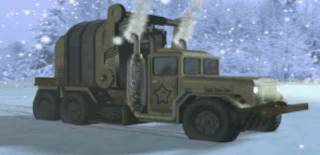Overview
The Mobile Construction Vehicle (commonly abbreviated MCV) is a non-combat unit that is used to create structures. When deployed on the battlefield this vehicle transforms into the Construction Yard. It was first implemented by Westwood Studios, the developer of the Command and Conquer series, in Dune II, their first RTS. It got a more prominent role in the first Command and Conquer, in any situation which required the construction of a new base, GDI and Nod commanders were normally supplied with either a Mobile Construction Vehicle or a Construction Yard, typically the former. This meant that commanders frequently became familiar with its usage. As a slow, and very expensive unit, it was necessary to protect it. Additionally, the Construction Yard's location was critically important as it needed to be protected, and near Tiberum fields.
 MCV From Red Alert 3
MCV From Red Alert 3 The Allies and Soviets were the first to develop this technology. It was also used by GDI and Nod forces during the First, Second and Third Tiberium Wars, as it remained an ideal way of setting up new bases. Although differing in design, all MCVs essentially fulfilled the same functions.
Evolution of the MCV
The first MCVs of World War II were oversized trucks carrying the basic construction equipment and prefabricates stored in the back. This design allowed them to travel roads like a normal truck would. Following the war, the MCV's design was overhauled and the new vehicle introduced in the 1990s was essentially a cross-breed between a tank and a truck. The massive rear part of the truck that carried the internal equipment of the construction yard was suspended on two massive treads while the forward part with the cockpit and utility truck was a classic wheeled vehicle. It proved very useful in traversing moderately rough terrain. The performance was so good that in the Second Tiberium War the MCV was using treads only. It was also outfitted with a powerful crane and rapidly deploying folding structure elements, allowing it to deploy quicker and more effectively.
After the war and the Firestorm Crisis passed, and the world was divided, GDI returned to the concept of a wheeled MCV, as the Blue Zones they control need fast, efficent transport on regular roads. The new MCV is essentially a massive truck with a small pilot's cockpit in the front.
 from command and conquer
from command and conquerThe Nod MCV is completely different. Given the conditions of Yellow Zones it controls, the MCV had to possess exceptional all terrain drive. The answer is intimidating - a massive quadrupedal walker resembling a giant insect was developed and their menacing appearance is a testament to Nod's excellence at powerful, lighting fast strikes. Some generals have found that they can quickly attack enemy infantry with it, by crushing them with its legs.
From Red Alert
The advent of highly mobile strike forces and the need for rapid deployment and projection of military force following the First World War has resulted in the development of the Construction yard, which was capable of estabilishing a base entirely on its own.
The Construction Yards were initially developed before World War II erupted and subsequently used by both sides of the conflict. Their respective Construction Yards both appeared identical but were used to construct different building prefabricates. Some commanders referred to them as 'conyards' for short. Both soviets and allies used Construction Yards that were identical to each other, however larger and different in appearance then the WWII era ones. The original conyard design was very simple, with a large hall closed off with a blast door, that housed the equipment responsible for preparing the prefabricates, connected to underground manufacturing facilities that produced them, via a large cargo elevator. The power generators sustaining the building were located in the back, in a separate section of the building, with vents on the roof. The crane in front of the yard was responsible for packing the prefabricates on trucks transporting them to the construction zones.
Mainstay of the RTS genre
Following the success of Westwood's Dune II and C&C, many of the RTS games in following years also used the concept of a deployable mobile base vehicle, though in time Blizzard's worker/construction unit idea from the WarCraft series became the most commonly used. Some notable games using MCV style units were Dark Reign (called Construction Rig and Base Mover), Krush Kill 'n Destroy (Mobile Outpost) and 7th Legion (Mobile Base Unit).
Log in to comment